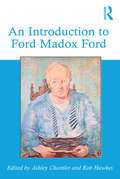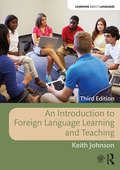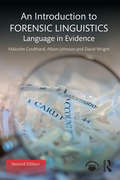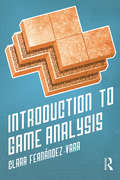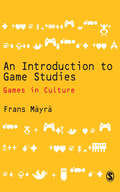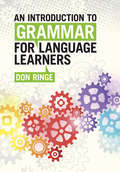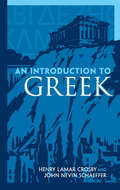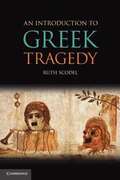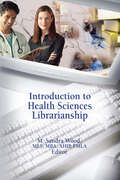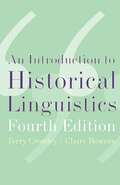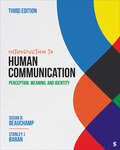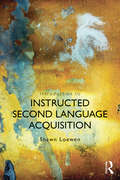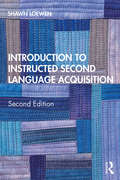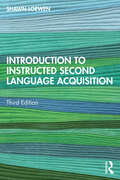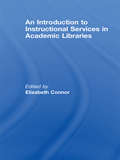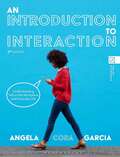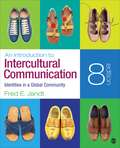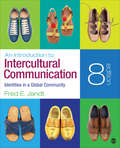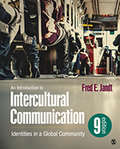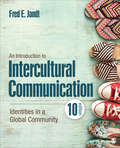- Table View
- List View
An Introduction to Ford Madox Ford
by Rob Hawkes Ashley ChantlerFor students and readers new to the work of Ford Madox Ford, this volume provides a comprehensive introduction to one of the most complex, important and fascinating authors. Bringing together leading Ford scholars, the volume places Ford's work in the context of significant literary, artistic and historical events and movements. Individual essays consider Ford's theory of literary Impressionism and the impact of the First World War; illuminate The Good Soldier and Parade's End; engage with topics such as the city, gender, national identity and politics; discuss Ford as an autobiographer, poet, propagandist, sociologist, Edwardian and modernist; and show his importance as founding editor of the groundbreaking English Review and transatlantic review. The volume encourages detailed close reading of Ford's writing and illustrates the importance of engaging with secondary sources.
An Introduction to Foreign Language Learning and Teaching
by Keith JohnsonAn Introduction to Foreign Language Learning and Teaching presents an engaging, student-friendly guide to the fields of foreign language learning and teaching. For students beginning their study of these fields, the book provides essential background information, dealing with language learning and teaching in a clear and comprehensible way. An Introduction will also be of value to teachers in training and those already working in the field, providing an up-to-date overview which focuses on contemporary issues while at the same time providing an important historical perspective. The book covers both theoretical and practical aspects of the field and provides suggestions throughout for discussion and workshop activities. Matters related to classroom and task-based teaching are dealt with at length, making the book suitable for use on practical training courses, especially where a degree of theoretical background is also required. Although most of the examples used deal with English as a foreign language, the book offers a suitable introduction for teachers of any foreign language. In this age of unfettered global communication the teaching and learning of foreign languages have never been more important. An Introduction to Foreign Language Teaching and Learning will give you the head start you need to get ahead of the field.
An Introduction to Foreign Language Learning and Teaching (Learning about Language)
by Keith JohnsonAn Introduction to Foreign Language Learning and Teaching provides an engaging, student-friendly guide to the field of foreign language learning and teaching. Aimed at students with no background in the area and taking a task-based approach, this book: introduces the theoretical and practical aspects of both learning and teaching; provides discussion and workshop activities throughout each chapter of the book, along with further reading and reflection tasks; deals with classroom- and task-based teaching, and covers lesson planning and testing, making the book suitable for use on practical training courses; analyses different learning styles and suggests strategies to improve language acquisition; includes examples from foreign language learning in Russian, French, and German, as well as English; is accompanied by a brand new companion website at www.routledge.com/cw/johnson, which contains additional material, exercises, and weblinks. Written by an experienced teacher and author, An Introduction to Foreign Language Learning and Teaching is essential reading for students beginning their study in the area, as well as teachers in training and those already working in the field.
An Introduction to Forensic Linguistics: Language in Evidence
by David Wright Malcolm Coulthard Alison JohnsonAn Introduction to Forensic Linguistics: Language in Evidence has established itself as the essential textbook written by leading authorities in this expanding field. The second edition of this bestselling textbook begins with a new introduction and continues in two parts. Part One deals with the language of the legal process, and begins with a substantial new chapter exploring key theoretical and methodological approaches. In four updated chapters it goes on to cover the language of the law, initial calls to the emergency services, police interviewing, and courtroom discourse. Part Two looks at language as evidence, with substantially revised and updated chapters on the following key topics: the forensic linguist forensic phonetics authorship attribution the linguistic investigation of plagiarism the linguist as expert witness. The authors combine an array of perspectives on forensic linguistics, using knowledge and experience gained in legal settings – Coulthard in his work as an expert witness for cases such as the Birmingham Six and the Derek Bentley appeal, and Johnson as a former police officer. Research tasks, further reading, web links, and a new conclusion ensure that this remains the core textbook for courses in forensic linguistics and language and the law. A glossary of key terms is also available at https://www.routledge.com/products/9781138641716 and on the Routledge Language and Communication Portal.
An Introduction to Forensic Phonetics and Forensic Linguistics (Learning about Language)
by Adrian Leemann Ria Perkins Grace Sullivan Buker Paul FoulkesThis textbook provides a practical introduction to the fields of forensic phonetics and forensic linguistics. Addressing how these fields are both distinct yet closely related, the book demonstrates how experts from both fields can work together to investigate and deliver justice in complex legal situations.With pedagogical features including real-life case studies, exercises, and links to further reading, topics covered include:• Profiling from spoken and written texts;• Disputed meaning, and how meaning is made and evolves;• Interviewing techniques, including working around those who might be considered linguistically vulnerable;• Author and speaker determination;• Audio enhancement and authentication of recordings;• Language analysis in the asylum procedure (LAAP).Accompanied by online audio and video resources as well as signposting readers to freely available software to aid their studies, this book is the ideal springboard for students beginning work in forensic phonetics, forensic speech science, forensic linguistics, and law and language.
Introduction to Game Analysis
by Clara Fernández-VaraGame analysis allows us to understand games better, providing insight into the player-game relationship, the construction of the game, and its sociocultural relevance. As the field of game studies grows, videogame writing is evolving from the mere evaluation of gameplay, graphics, sound, and replayablity, to more reflective writing that manages to convey the complexity of a game and the way it is played in a cultural context. Introduction to Game Analysis serves as an accessible guide to analyzing games using strategies borrowed from textual analysis. Clara Fernández-Vara’s concise primer provides instruction on the basic building blocks of game analysis—examination of context, content and reception, and formal qualities—as well as the vocabulary necessary for talking about videogames' distinguishing characteristics. Examples are drawn from a range of games, both digital and non-digital—from Bioshock and World of Warcraft to Monopoly—and the book provides a variety of exercises and sample analyses, as well as a comprehensive ludography and glossary.
An Introduction to Game Studies
by Frans MayraAn Introduction to Game Studies is the first introductory textbook for students of game studies. It provides a conceptual overview of the cultural, social and economic significance of computer and video games and traces the history of game culture and the emergence of game studies as a field of research. Key concepts and theories are illustrated with discussion of games taken from different historical phases of game culture. Progressing from the simple, yet engaging gameplay of Pong and text-based adventure games to the complex virtual worlds of contemporary online games, the book guides students towards analytical appreciation and critical engagement with gaming and game studies. Students will learn to: - Understand and analyse different aspects of phenomena we recognise as 'game' and play' - Identify the key developments in digital game design through discussion of action in games of the 1970s, fiction and adventure in games of the 1980s, three-dimensionality in games of the 1990s, and social aspects of gameplay in contemporary online games - Understand games as dynamic systems of meaning-making - Interpret the context of games as 'culture' and subculture - Analyse the relationship between technology and interactivity and between 'game' and 'reality' - Situate games within the context of digital culture and the information society With further reading suggestions, images, exercises, online resources and a whole chapter devoted to preparing students to do their own game studies project, An Introduction to Game Studies is the complete toolkit for all students pursuing the study of games. The companion website at www.sagepub.co.uk/mayra contains slides and assignments that are suitable for self-study as well as for classroom use. Students will also benefit from online resources at www.gamestudiesbook.net, which will be regularly blogged and updated by the author. Professor Frans Mäyrä is a Professor of Games Studies and Digital Culture at the Hypermedia Laboratory in the University of Tampere, Finland.
An Introduction to Genetics for Language Scientists: Current concepts, methods and findings
by Dan DediuDuring the last few decades we have discovered enormous amounts about our genomes, their evolution and, importantly for linguists and language scientists, the genetic foundations of language and speech. Accessible and readable, this introduction is designed specifically for students and researchers working in language and linguistics. It carefully focuses on the most relevant concepts, methods and findings in the genetics of language and speech, and covers a wide range of topics such as heritability, the molecular mechanisms through which genes influence our language, and the evolutionary forces affecting them. Filling a large gap in the literature, this essential guide explores relevant examples including hearing loss, stuttering, dyslexia, brain growth and development, as well as the normal range of variation. It also contains a helpful glossary of terms, and a wide range of references so the reader can pursue topics of interest in more depth.
An Introduction to Grammar for Language Learners
by Don RingeLearning a foreign language is much easier when it is approached with a knowledge of language structure ('grammar'), but many students find grammar mystifying. This text explains points of grammar straightforwardly using examples from several widely-studied languages, including English, so that students can see how the same principles work across different languages, and how the structures of different languages correspond both formally and functionally. The use of concrete examples makes grammar less abstract and easier to grasp, allowing students to relate what they are learning to knowledge that they already possess unconsciously; it simultaneously brings that knowledge up to a conscious level.
An Introduction to Greek
by Henry Lamar Crosby John Nevin SchaefferGenerations of students have discovered the enduring pleasures of ancient Greek with this classic text. Supplemented by exercises, readings, and review lessons, it presents concise but thorough coverage of grammatical forms and syntax. Students advance from the simple fundamentals of the alphabet and declensions to the complexities of conditional sentences, and they acquire a Greek vocabulary of more than 600 basic words.Each chapter begins with a Greek motto, offering insights into classical attitudes and values. Reading selections include the works of Plato, Herodotus, and Homer as well as excerpts from ancient playwrights and the New Testament. More than 120 illustrations depict images of Greek culture related to archaeology, history, and literature. This comprehensive introduction also features Greek-to-English and English-to-Greek glossaries, a complete grammatical appendix, and supplemental information on word formation and etymology.
An Introduction to Greek Tragedy
by Ruth ScodelThis book provides a brief and accessible introduction to Greek tragedy for students and general readers alike. Whether readers are studying Greek culture, performing a Greek tragedy, or simply interested in reading a Greek play, this book will help them to understand and enjoy this challenging and rewarding genre. An Introduction to Greek Tragedy provides background information; helps readers appreciate, enjoy, and engage with the plays themselves; and gives them an idea of the important questions in current scholarship on tragedy. Ruth Scodel seeks to dispel misleading assumptions about tragedy, stressing how open the plays are to different interpretations and reactions. In addition to general background, the book also includes chapters on specific plays, both the most familiar titles and some lesser-known plays - Persians, Helen, and Orestes - in order to convey the variety that the tragedies offer readers.
Introduction to Health Sciences Librarianship
by M. Sandra WoodGet the foundational knowledge about health sciences librarianship. The general term “health sciences libraries” covers a wide range of areas beyond medical libraries, such as biomedical, nursing, allied health, pharmacy, and others. Introduction to Health Sciences Librarianship provides a sound foundation to all aspects of these types of libraries to students and librarians new to the field. This helpful guide provides a helpful overview of the health care environment, technical services, public services, management issues, academic health sciences, hospital libraries, health informatics, evidence-based practice, and more. This text provides crucial information every beginning and practicing health sciences librarian needs—all in one volume. Introduction to Health Sciences Librarianship presents some of the most respected librarians and educators in the field, each discussing important aspects of librarianship, including technical services, public services, administration, special services, and special collections. This comprehensive volume provides all types of librarians with helpful general, practical, and theoretical knowledge about this profession. The book’s unique "A Day in the Life of . . . " feature describes typical days of health sciences librarians working in special areas such as reference or consumer health, and offers anyone new to the field a revealing look at what a regular workday is like. The text is packed with useful figures, screen captures, tables, and references. Topics discussed in Introduction to Health Sciences Librarianship include: overview of health sciences libraries health environment collection development of journals, books, and electronic resources organization of health information access services information services and information retrieval information literacy health informatics management of academic health sciences libraries management and issues in hospital libraries library space planning specialized services Introduction to Health Sciences Librarianship provides essential information for health sciences librarians, medical librarians, beginning and intermediate level health sciences/medical librarians, and any health sciences librarian wishing to review the field. This crucial volume belongs in every academic health sciences library, hospital library, specialized health library, biomedical library, and academic library.
An Introduction To Historical Linguistics
by Terry Crowley Claire BowernAll languages change, just as other aspects of human society are constantly changing. This book is an introduction to the concepts and techniques of diachronic linguistics, the study of language change over time. It covers all themajor areas of historical linguistics, presenting concepts in a clear and concise way. Examples are given from a wide range of languages, with special emphasis on the languages of Australia and the Pacific. While the needs of undergraduate students of linguistics have been kept firmly in mind, the book will also be of interest to the general reader seeking to understand langauge and language change. For this fourth edition, a number of new sections have been written, including many new problems and several datasets. Existing materials have been supplemented with new sections on grammaticalization, tonogenesis, morphological change, and using statistical methods in language classification.
Introduction to Human Communication: Perception, Meaning, and Identity
by Susan R. Beauchamp Stanley J. BaranNow published by Sage Introduction to Human Communication, Third Edition, offers a comprehensive and balanced survey of the discipline. Susan R. Beauchamp and Stanley J. Baran show students how central successful communication is to gaining effective control over perception, meaning making, and identity. After walking students through the basics of communication theory and research, they provide tools to help students become more competent, confident, employable, and ethical communicators. A diverse array of real-world examples and practical pedagogical tools help students apply what they′ve learned to a wide variety of communication contexts, including mass and digital communication, media literacy, health communication, interpersonal communication, organizational communication, and intercultural communication. This title is accompanied by a complete teaching and learning package. Contact your Sage representative to request a demo. Learning Platform / Courseware Sage Vantage is an intuitive learning platform that integrates quality Sage textbook content with assignable multimedia activities and auto-graded assessments to drive student engagement and ensure accountability. Unparalleled in its ease of use and built for dynamic teaching and learning, Vantage offers customizable LMS integration and best-in-class support. It’s a learning platform you, and your students, will actually love. Learn more. Assignable Video with Assessment Assignable video (available in Sage Vantage) is tied to learning objectives and curated exclusively for this text to bring concepts to life. Watch a sample video now. LMS Cartridge: Import this title’s instructor resources into your school’s learning management system (LMS) and save time. Don’t use an LMS? You can still access all of the same online resources for this title via the password-protected Instructor Resource Site. Learn more.
Introduction to Human Communication: Perception, Meaning, and Identity
by Susan R. Beauchamp Stanley J. BaranNow published by Sage Introduction to Human Communication, Third Edition, offers a comprehensive and balanced survey of the discipline. Susan R. Beauchamp and Stanley J. Baran show students how central successful communication is to gaining effective control over perception, meaning making, and identity. After walking students through the basics of communication theory and research, they provide tools to help students become more competent, confident, employable, and ethical communicators. A diverse array of real-world examples and practical pedagogical tools help students apply what they′ve learned to a wide variety of communication contexts, including mass and digital communication, media literacy, health communication, interpersonal communication, organizational communication, and intercultural communication. This title is accompanied by a complete teaching and learning package. Contact your Sage representative to request a demo. Learning Platform / Courseware Sage Vantage is an intuitive learning platform that integrates quality Sage textbook content with assignable multimedia activities and auto-graded assessments to drive student engagement and ensure accountability. Unparalleled in its ease of use and built for dynamic teaching and learning, Vantage offers customizable LMS integration and best-in-class support. It’s a learning platform you, and your students, will actually love. Learn more. Assignable Video with Assessment Assignable video (available in Sage Vantage) is tied to learning objectives and curated exclusively for this text to bring concepts to life. Watch a sample video now. LMS Cartridge: Import this title’s instructor resources into your school’s learning management system (LMS) and save time. Don’t use an LMS? You can still access all of the same online resources for this title via the password-protected Instructor Resource Site. Learn more.
Introduction to Instructed Second Language Acquisition
by Shawn LoewenIntroduction to Instructed Second Language Acquisition is the first book to present a cohesive view of the different theoretical and pedagogical perspectives that comprise instructed second language acquisition (ISLA), defined as any type of learning that occurs as a result of the manipulating the process and conditions of second language acquisition. The book begins by considering the effectiveness of ISLA and the differences between ISLA and naturalistic L2 learning. It then goes on to discuss the theoretical, empirical, and pedagogical aspects of such key issues in ISLA as grammar learning; interaction in the classroom; focus on form, function and meaning; vocabulary learning; pronunciation learning; pragmatics learning; learning contexts; and individual differences. This timely and important volume is ideally suited for the graduate level ISLA course, and provides valuable insights for any SLA scholar interested in the processes involved in second language learning in classroom settings.
Introduction to Instructed Second Language Acquisition
by Shawn LoewenNow in its second edition, Introduction to Instructed Second Language Acquisition continues to present a cohesive view of the different theoretical and pedagogical perspectives that comprise instructed second language acquisition (ISLA). Loewen provides comprehensive discussions of the theoretical, empirical, and pedagogical aspects of a range of key issues in ISLA, and has added to this edition a comprehensive exploration of the relationship between ISLA research and second language pedagogy. Also new is the addition of supporting features including end-of-chapter activities, points for reflection, and discussion questions, as well as thoroughly revised content to reflect the most recent research in ISLA. This is an essential resource for students new to ISLA, or working in Second Language Acquisition more generally.
Introduction to Instructed Second Language Acquisition
by Shawn LoewenNow in its third edition, Introduction to Instructed Second Language Acquisition continues to present a structured, comprehensive introduction to ISLA's theoretical, empirical, and pedagogical themes, as well as a range of key issues in research and practice.Designed for ease of teaching, the text includes separate sections for empirical evidence and pedagogical implications in order to demonstrate how research findings can successfully be implemented in the classroom. Activities and discussion questions, as well as points for reflection, facilitate discursive learning and critical thinking. This third edition has been thoroughly updated to reflect the latest developments in the field, along with new chapters on psychological, cognitive, and social individual differences, respectively.This is an essential core text for courses on ISLA, and recommended reading for classes in Language Acquisition more broadly.
An Introduction to Instructional Services in Academic Libraries
by Elizabeth ConnorMore than ever before, librarians are being called upon to contribute considerable energy, knowledge, and leadership to fostering the academic success of students through information literacy. Unique in its expansive breadth and in-depth approach, An Introduction to Instructional Services in Academic Libraries explores the latest methods and ideas for planning, delivering, and evaluating effective instructional sessions. Providing librarians with informative, real-world case studies culled from over three dozen prominent librarian-instructors from across the US and Canada, An Introduction to Instructional Services in Academic Libraries comprehensively covers the topics of experiential learning, hybrid models of library instruction, interdisciplinary inquiry through collaboration, introducing primary documents to undergrads, using case studies in credit-bearing library courses, teaching information literacy to ESL students, information literature for the non-traditional student, preparing an advanced curriculum for graduate students, librarians in the online classroom, and teaching distance education students. An Introduction to Instructional Services in Academic Libraries features numerous planning documents, survey instruments, handouts, active learning exercises, and extensive references which make it an ideal resource for educators and librarians everywhere.
An Introduction to Interaction: Understanding Talk in the Workplace and Everyday Life
by Angela Cora GarciaAn engaging introduction to the study of spoken interaction, this book provides a thorough grounding in the theory and methodology of conversation analysis. It covers data collection, techniques for analysis and practical applications, and guides students through foundational and new research findings on everyday conversations and talk in institutional contexts, from media, business, and education to healthcare and law. <p><p>Now thoroughly updated to showcase contemporary developments in the field, this second edition includes: <p>• New chapters on interaction in psychotherapy, educational settings and language learning and teaching <p>• Expanded coverage of doctor-patient communications, customer service and business meetings workplace interviews and online interactions, including social media, video gaming and livestreams <p>• A wider variety of research on other languages, including French, German, Italian, Finnish, Swedish, Arabic, Korean, Chinese and Japanese <p>• Multimodal analyses of interaction, focusing on the integration of embodied action and talk <p><p>Complete with student activities, recommended reading sections and a companion website featuring slides, quiz questions, and links to further transcripts, this book is an essential guide for doing conversation analysis and offers fresh insight into how we understand talk.
An Introduction to Intercultural Communication: Identities in a Global Community (Eighth Edition)
by Fred E. Edmund JandtAn Introduction to Intercultural Communication: Identities in a Global Community prepares today's students to successfully navigate our increasingly global community. Fred E. Jandt introduces essential communication skills and concepts that will empower readers to interact successfully with different cultures and ethnic groups. To spark student interest, Jandt offers readers unique insights into intercultural communication, at home and abroad, through an emphasis on history, culture, and popular media. Each chapter integrates material on social media, as well as extensive new examples from recent international news and events. Throughout the text, Jandt reinforces the important roles that stories, personal experiences, and self-reflection play in building our intercultural understanding and competence. The Eighth Edition adds depth to the coverage of theory and includes two new features: Focus on Skills provides expanded coverage of intercultural communication in practice, while Focus on Technology illustrates the impact of new communication technology on intercultural encounters. The new edition also introduces a new map program to provide students with additional context for discussion of cultures and regions across the globe.
An Introduction to Intercultural Communication: Identities in a Global Community
by Fred E. JandtAn Introduction to Intercultural Communication: Identities in a Global Community prepares today’s students to successfully navigate our increasingly global community. Fred E. Jandt introduces essential communication skills and concepts that will empower readers to interact successfully with different cultures and ethnic groups. To spark student interest, Jandt offers readers unique insights into intercultural communication, at home and abroad, through an emphasis on history, culture, and popular media. Each chapter integrates material on social media, as well as extensive new examples from recent international news and events. Throughout the text, Jandt reinforces the important roles that stories, personal experiences, and self-reflection play in building our intercultural understanding and competence. The Eighth Edition adds depth to the coverage of theory and includes two new features: Focus on Skills provides expanded coverage of intercultural communication in practice, while Focus on Technology illustrates the impact of new communication technology on intercultural encounters. The new edition also introduces a new map program to provide students with additional context for discussion of cultures and regions across the globe.
An Introduction to Intercultural Communication: Identities in a Global Community
by Fred E. Jandt“One of the best textbooks in intercultural communication for undergraduate students” —Mo Bahk, California State University, San Bernardino How does the Syrian refugee crisis, the election of Donald Trump, and the increasing number of “walls” being built to control immigration affect our ability to communicate and function across cultures? The highly anticipated Ninth Edition of An Introduction to Intercultural Communication prepares today’s students to successfully navigate our increasingly global community by integrating major current events into essential communication skills and concepts. To spark student interest, award-winning professor and best-selling author Fred E. Jandt offers unique insights into intercultural communication, at home and abroad, through an emphasis on history, culture, and popular media. Each chapter integrates material on social media, as well as extensive new examples from recent international news and events. Throughout the text, Jandt reinforces the important roles that our own stories, personal experiences, and self-reflection play in building our intercultural understanding and competence. New to the Ninth Edition New material on religion and identity, gender identity, and gender expression enables readers to explore the most current coverage on modern theories. Focus on Skills boxes have been expanded to include more activities that provide students with additional practice of intercultural communication skills. Focus on Technology boxes illustrate the impact of the newest communication technology on intercultural encounters. The popular map program provide students with additional context for discussion of cultures and regions across the globe and dynamic data displays that are popular with students. Give your students the SAGE edge! SAGE edge offers a robust online environment featuring an impressive array of free tools and resources for review, study, and further exploration, keeping both instructors and students on the cutting edge of teaching and learning. Learn more at edge.sagepub.com/jandt9e
An Introduction to Intercultural Communication: Identities in a Global Community
by Fred E. Jandt“One of the best textbooks in intercultural communication for undergraduate students” —Mo Bahk, California State University, San Bernardino How does the Syrian refugee crisis, the election of Donald Trump, and the increasing number of “walls” being built to control immigration affect our ability to communicate and function across cultures? The highly anticipated Ninth Edition of An Introduction to Intercultural Communication prepares today’s students to successfully navigate our increasingly global community by integrating major current events into essential communication skills and concepts. To spark student interest, award-winning professor and best-selling author Fred E. Jandt offers unique insights into intercultural communication, at home and abroad, through an emphasis on history, culture, and popular media. Each chapter integrates material on social media, as well as extensive new examples from recent international news and events. Throughout the text, Jandt reinforces the important roles that our own stories, personal experiences, and self-reflection play in building our intercultural understanding and competence. New to the Ninth Edition New material on religion and identity, gender identity, and gender expression enables readers to explore the most current coverage on modern theories. Focus on Skills boxes have been expanded to include more activities that provide students with additional practice of intercultural communication skills. Focus on Technology boxes illustrate the impact of the newest communication technology on intercultural encounters. The popular map program provide students with additional context for discussion of cultures and regions across the globe and dynamic data displays that are popular with students. Give your students the SAGE edge! SAGE edge offers a robust online environment featuring an impressive array of free tools and resources for review, study, and further exploration, keeping both instructors and students on the cutting edge of teaching and learning. Learn more at edge.sagepub.com/jandt9e
An Introduction to Intercultural Communication: Identities in a Global Community
by Fred E. JandtAn Introduction to Intercultural Communication equips students with the knowledge and skills to be competent and confident intercultural communicators. Best-selling author Fred E. Jandt guides readers through key concepts and helps them connect intercultural competence to their own life experiences in order to enhance understanding. Employing his signature accessible writing style, Jandt presents balanced, up-to-date content in a way that readers find interesting and thought-provoking. The Tenth Edition gives increased attention to contemporary social issues in today’s global community such as gender identifications, social class identity, and immigration and refugees. Included with this title: The password-protected Instructor Resource Site (formally known as SAGE Edge) offers access to all text-specific resources, including a test bank and editable, chapter-specific PowerPoint® slides.
